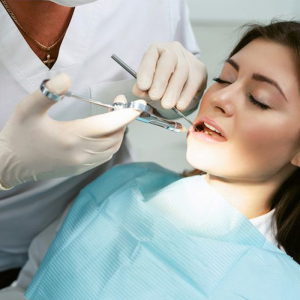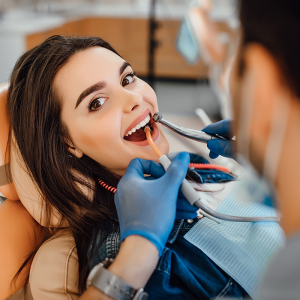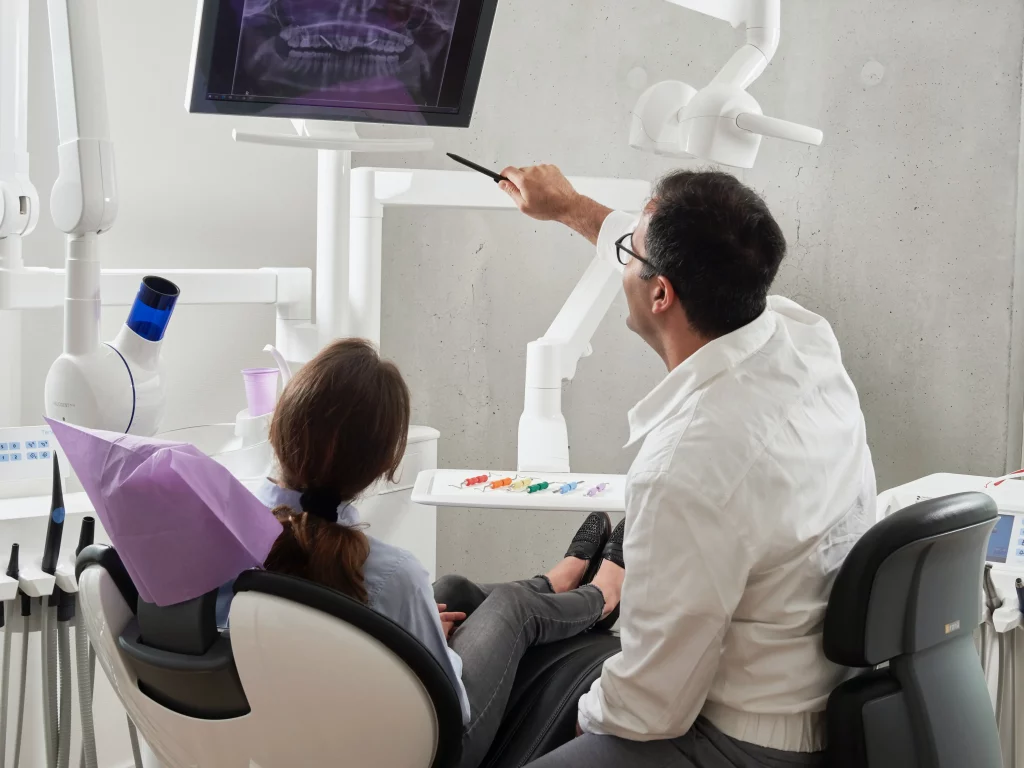Aesthetic Dentistry
SMILE DESIGN
PORCELAIN LAMINATES
It is possible to completely change your smile with very thin leaf-shaped restorations that we call lamina, which is bonded only on the front surface of the teeth.
With mock-up techniques, you can see your digital smile on the teeth and then if desired, in the mouth, before any intervention. Thus, you do not have to worry about how your teeth will look like at the end of the procedure.
Fine-structured porcelain laminates provide a bright appearance on the teeth with their transparency resembling natural tooth enamel. Due to its superior aesthetic properties, it is a frequently preferred treatment option in smile design.
Porcelain Laminate Veneer Treatment Process:
First of all, your dentist evaluates whether this procedure is suitable for you by photographing your teeth, examining them in detail, investigating your wishes and expectations. Like all other applications, this process may not be suitable for everyone. If appropriate, we continue with the following steps, if not, alternative proper actions are recommended.
Detailed photography are taken and both jaws are recorded with an intraoral scanning camera and their relationship with each other is determined.
First, a smile design is made on the photographs as “two-dimensional”. In this design, a personal smile is designed by evaluating many issues such as the relationship between teeth and lips, face shape, gender, the form of the existing teeth, the visibility and symmetry of the gums in the smile.
If the patient likes the two-dimensional design, the process can be started or if desired, the dimensioning and shaping can be made by transferring them to a different program and a personalized Mock-Up plate is obtained by making “three-dimensional” digital modeling in accordance with the finished shape. With this plaque, the way of smiling is shown practically on his own teeth. If desired, modifications can be made on it and the ideal result is obtained without any concrete action. Thus, it is possible to start the process as “carefree”.
In Mock-Up application, if shape changes on the gums are required, laser sizing and symmetry are provided to the gums by taking the plaque borders as a guide. This process is called pink aesthetics. For aesthetic results, pink aesthetics is as important as lamina making, which we call white aesthetics.
If a change has been made, the final state of the teeth is scanned with a camera over the Mock-Up material and sent to the laboratory.
The desired color is determined after shared decision.
Laminas are prepared in the laboratory in the light of all this information.
The laminae coming to the clinic are rehearsed, corrected if necessary and adhered to the teeth with special bonding materials.
Advantages of Porcelain Laminates:
They can be applied with minimal material loss with little or no roughening of the tooth surface.
They are both natural and aesthetic because they are thin and transparent.
Since the back surface of the tooth is never touched, they do not affect speech.
Since they are applied one by one, they do not adversely affect gum health.
The desired color, surface feature and form can be provided to the teeth with laminates.
They preserve their colors and textures for many years as they are made of state-of-the-art ceramic materials. They are not affected by coloring foods and tobacco products.
NO-PREP (PREPLESS) VENEER
No-Prep Veneer is a laminate veneer (leaf porcelain) application that is made directly by measuring, without any abrasion, without damaging the originality of the teeth. The difference from conventional laminate veneers is that it is applied without any preparations such as roughening or abrasion on the tooth surface. In this way, it can be removed at any time and allows you to use your own teeth in their original form.
It is a very successful method in terms of getting quick and aesthetic results in dental problems such as unprocessed veneers, color problem, material loss and tooth gap problem. They are adhered to the teeth one by one with a special bonding technique and since they are supported by natural teeth, their durability is not less than the original tooth. Even if there is decay from the inside of the tooth, the veneers are not damaged. It is not easily discolored due to its material feature, but it can reflect the color change that may present the tooth because it is very fine. No-prep veneers can be used comfortably for long periods of time. As with any dental restoration, good care and regular control prolongs the usage period.
– No Anxiety: The originality of your teeth will not deteriorate, and when desired you can return your teeth to their former state as if it had never been removed.
– No Pain: Since there is no shaving, it is completed in a short time without anesthesia.
First of all, your dentist evaluates whether this procedure is suitable for you by examining your teeth in detail, asking about your wishes and expectations. Because, like all other applications, this process may not be suitable for everyone. If appropriate, we continue with the following steps, if not, alternative options are recommended.
Detailed photography is taken and both jaws are recorded with an intraoral scanning camera and their relationship with each other is determined.
First, a smile design is made on the photographs as “two-dimensional”. In this design, a customized smile is designed by evaluating many issues such as the relationship of teeth and lips, face shape, gender, the form of the existing teeth, the visibility and symmetry of the gums in the smile.
If the two-dimensional design is accepted, the process can start or if desired, the dimensioning and shaping can be made by transferring it to a different program, and a personalized Mock-Up plate is obtained by making “Three Dimensional” digital modeling in accordance with the finished shape. With this plaque, the potential smile is shown practically on his own teeth. If desired, modifications can be made on it and the ideal result is obtained without any concrete action. Thus, it is possible to start the process “carefree”.
In the Mock-Up application, if shape changes on the gums are required, laser sizing and symmetry are provided to the gums by taking the plaque borders as a guide. This process is called pink aesthetics. For aesthetic result, pink aesthetics are as important as lamina making which we call white aesthetics.
If a change is made, the final state of the teeth is scanned with a camera over the Mock-Up material and sent to the laboratory.
The desired color is agreed by the patient and the dentist.
Laminas are prepared in the laboratory according to the given information.
The laminate coming to the clinic are rehearsed, corrected if necessary and adhered to the teeth with special adhesive materials.
Laminate veneers should be made if the tooth color is very dark and more than a few tones of bleaching is desired, if the teeth are cramped or in a position requiring abrasion.
If the teeth are small in size, if there is a gap between the teeth and if excessive bleaching is not desired, a no-prep veneer should be applied.
In laminate veneer applications, after some abrasion of the enamel layer, the laminas are applied to the tooth surface, while no-prep veneers are not abraded.
If the laminate veneers are removed, new laminas must be made, if the no-prep veneers are removed, the teeth can be used in their original state.
According to the budget and aesthetic indications, the most appropriate treatment is given to the patient.
BONDING
Dental bonding is one of the most common dental procedures. It helps to restore a persons smile to perfection. The procedure is very easy to perform and entirely painless, which prevents the patient from facing any anxiety regarding the condition as well. There are little to no complications of this procedure and if some arise, it can always be reversed. For a dentist, one of the most important things to preserve is the patients smile. But very often, the patient must deal with issues that directly impact their smile. This could include chipped teeth, gaps in the teeth or alterations to the shape of the teeth and this is where bonding comes in. Bonding is used to restore or repair a persons smile by eliminating these factors and making their teeth appear perfect.
The procedure of bonding is simple and painless. There are a few steps to it that need to be followed to ensure that the material remains in place. First, the dentist finds a composite shade which matches the natural color of the teeth. After that, the tooth surface is roughened and a bonding agent is applied to the rough surface. This helps the composite resin to stick to the tooth. After that, the resin is applied to the tooth, then molded to fit the shape of the tooth. The filling is smoothened to appear undetectable. Blue light is used to cure the composite, making it bond to the tooth and remain sturdy. If there are any rough surfaces or the patient has a problem with occlusion, the dentist shapes the tooth and polishes it till it looks completely natural. Bonding is often used to treat discoloration of teeth as well which can result from diseases, drug use, injuries, or other problems.
There are a few alternatives to bonding and one of the most common alternatives includes porcelain veneers. Veneers are ceramic shells that bond tightly to the front of the teeth. It is a much sturdier alternative to bonding but is much more expensive. Unlike bonding, the procedure of veneering is not reversible. However, it is important to remember that bonding is usually used to treat minor defects in the teeth whereas veneers often hide major defects and help to restore functionality to the teeth as well.
EMPRESS | EMAX
Empress Restorations
The IPS Empress System gives the closest look to the original healthy tooth in restoration of defects on the teeth and in aesthetic applications (Smile Design).
The “Leucite Glass Ceramic” material was produced by Ivoclar company nearly twenty years ago. Although similar ones are produced by different companies, it has become a generic brand. More than 40 million IPS Empress restorations have been applied in the world so far and the lamina porcelains applied on different patients in our clinic for 16 years have given clinical confidence with long-term satisfactory results. IPS Empress has been pressed and applied from its first release and can now be applied by milling using CAD / CAM technology.
IPS Empress glass ceramic is a very aesthetic leucite-based material spreading the incident light naturally and creating a balanced chameleon effect. It provides a comfortable use with its translucency and real-like appearance. Since the IPS Empress Esthetic, press ceramic and IPS Empress CAD machinable ceramic blocks are equivalent in terms of material content, both materials show resistance to 160 MPa in addition to their light optical properties.
All-ceramic single tooth restorations in veneers, inlays, onlays and crowns therefore adapt to their natural environment. A careful preparation of the teeth positively influence the adaptation and the duration of the restorations. Tooth structure can be preserved with minimum tooth erosion.
Advantages of Empress Restorations:
Working with the pressing technique and CAD / CAM (digitally design and production) technique to get aesthetic results according to the need,
Ability to give a natural chameleon effect for optimal color matching of the studied teeth with their surrounding ones,
Obtained from leucite glass ceramic with 160 MPa bending strength, proven to be used 40 million times.
In which restorations the IPS Empress system can be used ?
Single Tooth Restorations,
Inlays,
Vaneers,
Anterior Crowns
Posterior Crowns
In which restorations the IPS Empress system can be used ?
Dental Bridges,
Bridge over Implant
Indications
Single tooth restorations inlays, onlays, veneers, anterior and posterior crowns.
IPS E.max CAD Layering Solutions
E.MAX RESTORATIONS
Excellent durability,
IPS E.max CAD Veneer solutions are veneer structures produced with CAD / CAM (Digitally design and production) for zirconium oxide infrastructures. It is an unrivaled combination of lithium disilicate and zirconium oxide. It provides the construction of highly durable, aesthetic dental and implant-supported bridge restorations.
With digital production, it is possible to save time and apply restorations with low error rate.
Advantages
Very aesthetic and durable thanks to the combined use of lithium disilicate (LS2) and zirconium oxide (ZrO2).
It can adhere well with ceramic.
It can be characterized by customizable tooth colors.
Provides digital production opportunity in a short time.
Indications
Crowns
Bridges (Over-tooth and over-implant multi-member)
MONOLITHIC ZIRCONIUM
The biggest difference of monolithic zirconium from normal zirconium core materials is that it is not damaged by contact with saliva directly in the mouth environment and is more aesthetic than normal zirconium material. They can be used in one piece or on chewing surfaces where the chewing force is the highest, without the need to process the less resistant porcelain material on it.
In zirconium core materials obtained from normal zirconium blocks, porcelain should be completely processed on it and not open to the mouth environment.
– The other reason why monolithic zirconiums do not require porcelain overgrowth is that they can be aesthetically given the tooth color and form as desired and they can be easily polished so that results that are very close to tooth brightness can be obtained.
-Especially, for people who have undergone posterior area and bridge procedures, the restoration process can be done with monolithic zirconium, as well as porcelain processing on the front (visible) surfaces of the teeth in front teeth and other visible areas, and more aesthetic results can be obtained.
– Since it does not require porcelain share, it can be worked fine especially in the junction area of the tooth and gum to provide a full aesthetic appearance.
– Since the light permeability is higher than normal zirconium core material, a natural dental effect can be given.
– The process is mostly based on technological production with the technique of CAD / CAM (designing on a computer and manufacturing with a computer-aided milling system). Porcelain stacking process is either absent or very little when necessary. This enables faster production as well as high quality.
– In prosthetic treatment of people with tooth clenching problems, individuals with fractures in their teeth.
– Dental restoration procedures for people who have limited time for treatment with the advantage of fully digital work.
– In dental treatments that require durable coating such as implant prostheses.
– People with fractures and abrasion problems in the anterior teeth, especially as a result of trauma.
– Dental restoration of people who have difficulty in biting as a result of abrasion and who have advanced tooth sensitivity.
– Monolithium zirconium coating is used to treat damaged teeth as well discoloration of the gums.
Information about the monolithic zirconium coating application process are listed as follows:
Primarily, the finished form of the restorative procedure to be made on the teeth is planned. With this planning, in the desired cases, the three-dimensional finished model can be digitally processed before any operation is performed on the teeth, then the digital model can be removed and processed as if it was finished in the mouth, and the patient can be shown the finished form without any action. In this way, the erosion process on the teeth can be kept at a minimal level.
Damages in the teeth are detected and the teeth are shaped in a suitable structure at the level of need in digital modeling.
The measurements of the teeth are preferably taken with intraoral scanning systems (3Shape Triodent Scanner) and the measurements are sent to the laboratory. Here, by transferring to special programs in computer environment, personal closing and aesthetic planning and design are made.
After the design, the production is made with a 3D printer for trial purposes, and the necessary corrections are made by trial inside the mouth.
This design is matched with zirconium blocks after corrections, if necessary, and shaped by the scraping method in the milling system.
Monolithic zirconium is very soft and brittle when it comes out from the scraping process. It is transferred to the furnace for cooking (sintering), which takes an average of 8 hours for hardening. After this firing process, a hard and aesthetic result that can be durable up to 1200 mPa is obtained. If necessary, porcelain can be added to the aesthetic areas.
The completed job is at very ideal levels in terms of tissue adaptation and adaptation to teeth and is easily adapted to the teeth.
It is a biological material and almost no tissue allergy is seen.
A good adaptation and the monoblock of the material increases the resistance and reduces the risk of porcelain teeth breaking and chipping (small size fractures in porcelain).
The grey color appearance in the gingiva joint, which is especially seen in metal-supported porcelains and increases over time, does not exist in these materials.



COMPOSITE FILLINGS
Composite fillings have entered the world of dentistry with a boom. The new dental technology has helped patients with numerous procedures and made cosmetic dentistry more renowned. Here are the things you should know about composite fillings.
What Are Composite Fillings?
COMPOSITE fillings are made from a composite resin and have a natural tooth-colored appearance. This natural appearance is thanks to the fine glass and plastic particles, along with some other minute elements mixed in the resin and shaped according to the tooth structure.
Advantages of Composite Fillings
Here are some advantages of using composite fillings instead of traditional amalgam fillings:
They Mimic the Tooth Cosmetically
Composite fillings have a unique composition that mimics the tooth cosmetically. However, color is not the only factor contributing to the composite filling’s tooth-like appearance. The opacity of the tooth and its different shades can also be achieved using composite fillings.
They Protect Your Tooth Structure
Since composite fillings are widely used for decaying teeth, these fillings can also protect the remaining tooth structure due to their sturdy composition and support around the tooth. Moreover, composite fillings are also used for treating chipped teeth to help gain their aesthetics by adding the filling. Hence, composite fillings can work well for both purposes, whether your teeth have undergone more considerable damage or require some minor flaw coverage.
They Are Durable
Although less durable than their counterparts, composite fillings can last 7 to 10 years, depending on your teeth care routine. Your oral hygiene habits can significantly increase composite fillings’ longevity.
They Require Less Time
Depending upon the number of teeth that need to be replaced, most composite filling appointments can end in a day time. The doctor dries out your mouth because composite fillings require a dry surface. Once your decayed tooth is removed, the filling is layered on the area while it’s treated with special UV light. The UV light helps dry up the layers fast so that another layer can soon be placed atop. Once the tooth structure is achieved, the process ends.
The straightforward and time-convenient procedure has made composite filling a sought-after dental procedure.
Common FAQs Regarding Composite Fillings
Here are some of the general FAQs regarding composite fillings answered:
How long does the composite filling injection site hurt?
The site where the composite filling has been placed might be sensitive for one to two days. However, common painkillers can easily help reduce the pain so that it doesn’t become a hindrance in your daily life activities.
What things might affect the composite filling’s appearance?
If you’re into staining beverages such as tea or coffee, you might want to stay away from them. These beverages can alter the shade of the filling and make it more noticeable, indicating that it is not a natural tooth.
Can I brush or floss after getting a composite filling?
As discussed previously, good oral habits will increase the filling’s longevity. However, ensure you’re gentle with your brush so that you don’t hurt any of your teeth, especially your composite filling.
INLAY | ONLAY
Ceramic Inlay/Onlay Restoration
Inlays and Onlay are indirect restorations to heal endodontically treated teeth. They are either made of ceramic or composite material. Ceramic fillings can repair minor decays or moderate tooth structural loss. However, ceramic fillings are not stable for deeper cavities, and if the structure of the back teeth is severely depleted, it is challenging to simulate natural teeth.
Inlays and onlays indirectly produced and composed of composite or ceramic are the ideal options if the tooth is damaged severely. It is also a suitable option if the tooth can not recover with simple filling yet is not severe enough to require a complete crown.
Dentists directly apply dental fillings to patients’ teeth, whereas dental technicians or digital manufacturers make inlays and onlays externally, and then the dentist bonds them to the patient’s tooth.
A dentist may make a traditional dental impression or use a camera for computerized work to fabricate onlays and inlays. Since they are made of durable, sturdy materials, inlays and onlays must regularly be cleaned and flossed like other teeth.
Inlays and Onlays: An Overview
Partial crowns are a common term for inlays and onlays. They fit over or within the tooth, with the natural tooth as a base. It strengthens the tooth, improves its form and protects against potential damage. When the tooth’s cusps are undamaged, the inlay may be fitted directly into the tooth. When the damage is extensive, an onlay is applied.
Chemical Structure
When the treatment site is situated in the “smile zone,” porcelain often produces the finest aesthetic results, while gold gives the most dependability and longevity. Although porcelain is remarkably durable against wear, grinding or clenching the teeth can wear down adjacent teeth.
Ceramic inlays and onlays are porcelain-made. Porcelain is commonly used in dentistry to develop restoration that blends in well with the natural shade of the tooth and offers the same functionality.
Ceramic restorations are a durable alternative to fillings and are typically stain-resistant. However, although made of sturdy material, ceramic is prone to fracture and is not as resistant to wear as gold.
The Procedure
Step 1: Removal of cavity fillings
Before placing a restoration, your dentist will extract any existing fillings from the teeth.
Then, your dentist will sculpt and prep the tooth to make it simpler to install the inlay or onlay.
Step 2 – Inlay/onlay Impression
An impression of the cracked or broken tooth is made during the initial session. The impression determines which inlay/onlay material is suitable.
Step 3: Temporary Filling
This step is necessary to preserve the preparation for installing the restorative inlay/onlay. It also protects the sensitive tooth from exposure to hot or cold foods or beverages.
Step 4: Installation of Inlay/Onlay
This step calls for another appointment when the dentist will finally insert the Inlay/Onlay restoration once it is ready.
Inlays and Onlays: Ceramic vs. Composite
Most ceramic inlays and onlays are made of glass, accompanied by a few crystals incorporated for sturdiness. Different materials are used with a resin matrix to create composite inlays and onlays.
Ceramics, like glass, are so fragile and more vulnerable to breaking than composites. On the other hand, ceramics are stronger than composites; as a result, they are far more wear-resistant but they can also cause the adjacent tooth’s enamel to wear out more quickly than expected.
Ceramics are incredibly biocompatible. This property is in contrast to composites with a resinous matrix, where incomplete polymerization might lead to monomers being dispersed into the mouth and posing hazards.
On the other hand, ceramics’ lengthy manufacturing process makes them less advantageous than composite materials, which are affordable and much simpler to polish.
TEETH WHITENING
If you are satisfied with the shape, form and alignment of your teeth but are not satisfied with the color, it is possible to achieve a whiter, well-groomed and healthy appearance with today’s bleaching techniques and materials. Two types of bleaching procedures are performed in the clinic, which we call in office- type and home-type whitening.
In the office-type whitening process, special whitening gels are applied on the teeth and then the gel is activated using special light sources. The activated gel provides several tones of whitening of the teeth in a single session.
The dentist can provide you with the whitening gel that you can apply at home with the help of transparent trays specially prepared for you in the home-type whitening process. Home bleaching should also be done under the control of the dentist.
After it is determined by your dentist that there is no open caries or gum disease in the mouth, the whitening process applied with the correct technique and appropriate material does not cause any harm to the teeth.
After the bleaching process, the teeth return to their original form within 1-2 years. However, this period may vary depending on the person’s daily habits and tooth structure. During this period, acidic and colored drinks should be avoided and excessively hard tooth brushing should not be done.
Implant Supported Prostheses
Implant-supported prostheses are such an addition to the dentistry world and have gained popularity over the years due to their safe nature for oral health. The implant-supported prostheses can last for 10 to 20 years. However, your oral hygiene habits significantly affect this lifespan. Since the appearance and comfort matches the natural teeth, implant-supported prostheses impart more confidence. They also help in chewing food properly. The biological material used in implant-supported prosthetics allows it to be more compatible with the bone structure and fix well without causing discomfort
Zirconia and BioHPP are two materials that have been discovered as the most valuable materials in implant-supported prostheses. With BioHPP, the chewing forces across the horizontal and vertical lines are reduced. Therefore, prosthetics become more durable. On the other hand, with zirconia, an inert material, there are numerous aesthetic advantages. Moreover, the chewing forces are also distributed, which helps reduce its effects. These two materials are mainly combined to achieve an aesthetically pleasing smile that lasts longer while also being physiologically comfortable around the mouth to impart confidence.
The implant-supported prostheses are decided as a customized solution as the jaw’s bone structure and the holding force of hard and soft tissues play a vital role in the decision-making.
- Removable dentures
- Ceramic retained implant prostheses
- Screw-retained implant prostheses.
- Dentists can remove the implant-supported hybrid prosthesis.
Another factor that massively affects your health as well and increases the longevity of your implant-supported prostheses is the habit of removing them at night before going to sleep. While you may be tempted to keep them in, taking them out for the night is essential so that if you have clenching habits that can affect the implant-supported prostheses, then these habits do not cause severe fractures on the surface.
REMOVABLE PROSTHESES
Removable Dental Prostheses
Most patients prefer to recover their lost teeth with dentures, unquestionably the most popular removable dental prostheses available. In contrast to previous developments in dental technology, the reason for patients’ preference is that removable dental prostheses are not invasive and will not necessitate unpleasant recuperation or surgical procedures.
Removable dental prostheses may be quickly taken out when not used and changed as needed as they are held in place by the structures in the oral cavity around them.
Partial Dentures
Removable partial dentures are secured or fastened to the patient’s surviving teeth for individuals with a few lost teeth. In partial dentures, the prosthetic teeth are often cemented to a plastic foundation joined to a metal frame that keeps the denture in place. To prevent partial dentures from shifting or falling out, internal hooks that grip onto surrounding teeth are needed. Besides filling in the spaces left by lost teeth, removable partial dentures also protect the natural teeth that are still there.
Complete Dentures
Complete dentures replace every tooth in the patient’s upper and lower jaw. Once the gums have fully recovered following a tooth extraction, a traditional complete denture is installed in the mouth. In the elderly, the gums are left to heal when most teeth are missing or have been extracted for a reason. In this case, a person might have to spend some time without teeth. However, in younger patients, this may not be necessary.
Although the patient will be without teeth, the removable dental prosthesis will become loose over time as the tissues and gums recover and recede, necessitating a readjustment.
The brand-new dentures will initially feel odd and sometimes unpleasant. The patient might experience hyper-salivation, difficulties chewing or speaking and problems with tongue adjustment and movement. However, these side effects will soon subside when the patient is habituated.
People may consider detachable dental prostheses for the following reasons:
- Cost: Removable dentures are frequently far less expensive than dental implants.
- Option to adjust: Removable dentures can occasionally be customized by adding more teeth, giving patients the option to replace further lost teeth if the situation warrants it.
- Possibility of preserving natural teeth: One can save adjacent teeth with partial dentures.
- Non-invasive treatment: If there is no extraction needed, removable prostheses are 100% non-invasive.
The ability to switch from removable prostheses in individuals with a fully edentulous mouth depends on how many healthy bones they still have. Implants are inserted directly or after adding a surgical graft if there has been excessive bone loss due to missing teeth.
When a patient’s lower jaw is missing teeth, using a denture can be quite challenging since the patient has a lot of difficulties biting, speaking or chewing due to the tongue’s continual motion within the mouth. Prosthesis-related issues with the lower jaw, tongue, cheeks, lips and chewing motions can be resolved with implants. Furthermore, complications like nausea are no longer an issue because of the design’s palate closure. Dentists often resort to implant-supported or fixed prostheses for full or partial tooth loss.
When a patient loses one or more teeth, the traditional bridge replacement for the space comprises cutting, shrinkage and tissue loss. However, in the case of implants, the screws behave like a tooth’s root that gives the prosthetic crown a foundation. It mimics your natural teeth and there is no fear of loose teeth or the need for re-adjustment.
As for implant-supported dentures, the complications that come with removable prostheses such as drooling, displacement and discomfort are permanently gone for the good.





